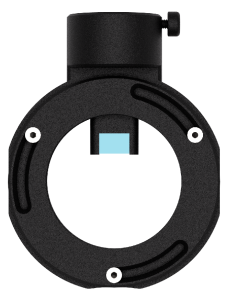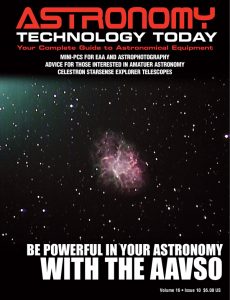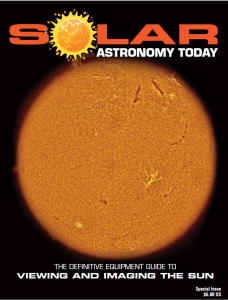The Pegasus Astro Indigo Off Axis Guider is a thin yet solidly designed OAG which can easily be utilized with the Pegasus Astro Indigo Filter Wheel. The main advantage having an OAG is that it used the same optical path with your main imaging camera. This avoids any issue with differential flexure that can occur when using a separate guidescope on top of your main telescope.
 The Pegasus Astro Indigo Off Axis Guider thin design offers a backfocus of just 10mm plus 4mm of the telescope adapter – 14mm in total. The 10mm thickness design is solid enough to support needed heavy imaging equipment. The clear aperture is 53.5mm. The Indigo OAG can be directly mounted onto the Indigo Filter Wheel and a combination of both products offers a 19mm plus 14mm (33mm total) of backfocus optical distance.
The Pegasus Astro Indigo Off Axis Guider thin design offers a backfocus of just 10mm plus 4mm of the telescope adapter – 14mm in total. The 10mm thickness design is solid enough to support needed heavy imaging equipment. The clear aperture is 53.5mm. The Indigo OAG can be directly mounted onto the Indigo Filter Wheel and a combination of both products offers a 19mm plus 14mm (33mm total) of backfocus optical distance.
The OAG is CNC made of airplane 6061 aluminum alloy which ensures a lightweight and solid piece of equipment. The prism height can be easily adjusted to allow better illumination of the field of view of the guiding camera. If your imaging camera sensor is large, the prism can be moved (and secured with set screws) upwards to disallow blockage of the sensor’s optical path. A 12×8 mm fully multicoated & anti-reflection mirror offers high illumination to your guiding camera. Stars are round and bright across the OAG ‘s field.
The Pegasus Astro Indigo Off Axis Guider supports the 62mm through hole pattern for direct connection with the latest CMOS cameras and filter wheels. The guiding camera connection is a 1.25” barrel and the orientation of image train framing can be achieved by the 3 screws that allow telescope adapter to slide inside the slots.
You can learn more about the Pegasus Astro Indigo Off Axis Guider here.

 And to make it easier for you to get the most extensive news, articles and reviews that are only available in the magazine pages of Astronomy Technology Today, we are offering a 1-year magazine subscription for only $6! Or, for an even better deal, we are offering 2 years for only $9. Click here to get these deals which only will be available for a very limited time. You can also check out a free sample issue here.
And to make it easier for you to get the most extensive news, articles and reviews that are only available in the magazine pages of Astronomy Technology Today, we are offering a 1-year magazine subscription for only $6! Or, for an even better deal, we are offering 2 years for only $9. Click here to get these deals which only will be available for a very limited time. You can also check out a free sample issue here.
The sun is more active than it has been in years! If you’d like to learn more the technology behind solar observing, solar imaging and more, you can check out our free publication, “The Definitive Guide to Viewing and Imaging the Sun”. You don’t have to sign up or provide any information, simply click here and enjoy reading!

